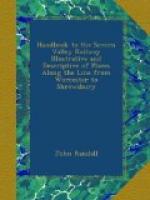And tradition adds that, in consequence of a vow made by his second wife, Adeliza, the church close by was built upon the borders of the forest, then the favourite hunting-ground of the Norman earl. The church, like other neighbouring structures of ancient date, was built of tuffa, or travertine, a material found in the beds of brooks in the district, and portions of the chancel, including its fine Norman arch and pillars, are still composed of the same. Among old endowments of the church, is one, from a source unknown, of a piece of land, the proceeds of which defray the expense of ferrying persons attending church across the Severn.
The old man at the ferry is a fisherman, who knows well where to get “a rise” of trout, or to hook a grayling, and where to look for pike, or perch, or gudgeon.
[Perch and Gudgeon: 18.jpg]
In the parish of Quatford is Eardington, celebrated for the manufacture of iron for guns, wire, and horse nails; and parochially and manorially combined with Eardington is the More, the ancient tenure of which indicates the manufacture of iron here at a very early period. By it the tenant was required to appear yearly in the Exchequer, with a hazel rod of a year’s growth, and two knives, the treasurer and barons being present. The tenant was to attempt to sever the rod with one of the knives, the other knife was to do the same work at one stroke, and then be given up to the king’s chamberlain; a custom which was continued until recently.
BRIDGNORTH
[Bridgnorth: 19.jpg]
Population, 6,569.
Market day—Saturday. Fairs—January 20th, February 17th, May 1st, June 9th, July 14th, August 18th, September 15th, October 29th, December 28th.
Principal Hotel—The Crown, for which, as well as for the Swan, the Raven, and the George, see Advertisements.




